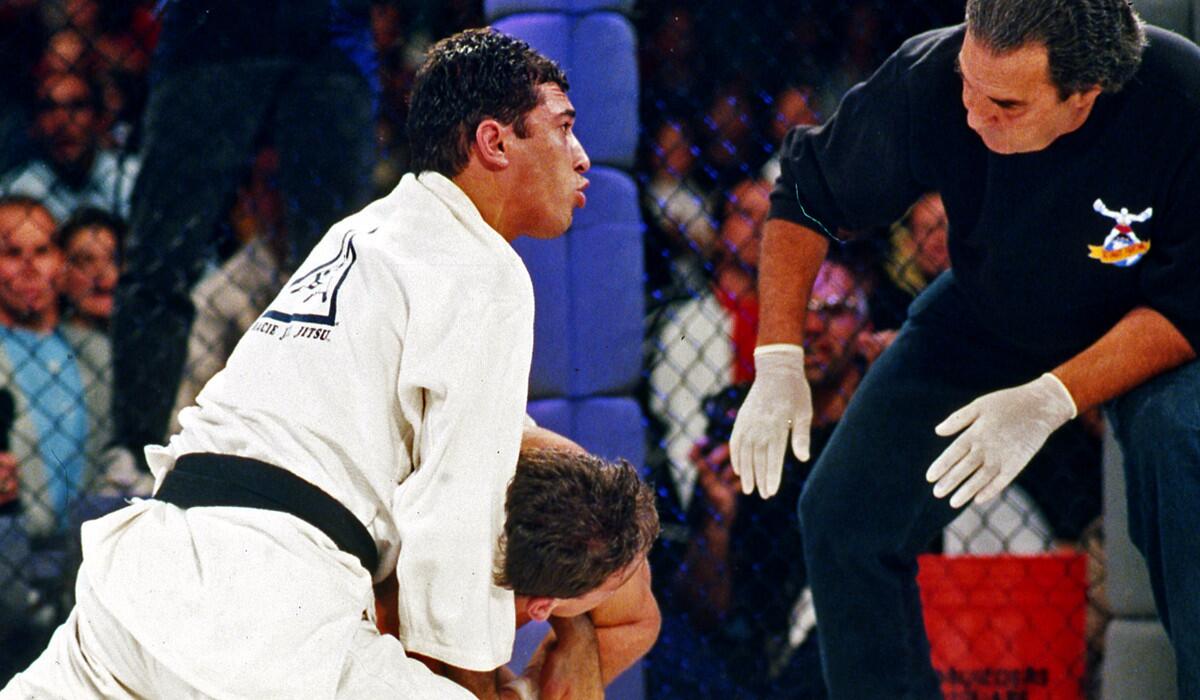Jiujitsu icon Royce Gracie is fired up about mixing it up with old rival Ken Shamrock

Royce Gracie, left, in action during UFC 1 on Nov. 12, 1993 at the McNichols Sports Arena in Denver.
- Share via
The full head of hair is gone, the blood-stained martial arts robe he wore while winning UFC 1 is secured away in storage.
Never mind the remnants of his youth; Royce Gracie is back to fight.
Gracie, 49 and more than 22 years after he won the Ultimate Fighting Championship debut tournament, will complete his trilogy with fellow mixed martial arts legend Ken Shamrock at Bellator’s main event Friday in Houston.
“This one is just personal because it’s Ken and he talks a lot. He’s self-proclaimed as the baddest man alive as the godfather of MMA,” Gracie said after a recent workout at a gym near Dodger Stadium. “How can you be the godfather when you lost to me? I’ve been fighting longer than he has, my family’s been doing it longer.”
Gracie’s father, Helio, and uncle, Carlos, developed their form of jiujitsu in Brazil and brought to the U.S. by Royce’s older brother, Rorion, who teamed up with promoter Art Davie to stage the first UFC contest in Denver.
UFC 1 featured boxing, wrestling, karate, judo and sambo, with minimal rules and no time limits.
Royce Gracie emerged as UFC’s first star because he beat three opponents on that card, prompting through various chokes to get boxer Art Jimmerson, wrestler Shamrock and savate fighter Gerard Gordeau to tap out.
“I won by pure technique. … I learned distance, to know what’s coming at me,” Gracie said. “It wasn’t endurance. It was strategy, knowing more than my opponents knew.”
What was UFC 1 like?
“My brother, who created the UFC, had a vision,” Gracie said. “He knew that people wanted to see who was the best fighter. People have curiosity, what style was the best? Boxing, wrestling, Gracie jiujitsu? It was a quest to find out. The only way to find out is get in a cage … no gloves, no time limit, let’s do it.”
MMA has advanced into a mishmash of various fighting skills, but Gracie jiujitsu remains a vital discipline in the sport.
“Now it’s about who’s better prepared, who has the best strategy,” Gracie said. “That’s what it’s become.”
Gracie’s return to the cage resembles a scene from the Sylvester Stallone-Robert De Niro “Grudge Match” film. Bellator President Scott Coker recalls Shamrock walking into a Dave & Buster’s for a Bellator fanfest last year, glaring at Gracie and telling Coker, “I want to fight that guy.”
Regrets have festered in Shamrock, 52, after losing to Gracie in 57 seconds in the semifinals of UFC 1, then battling Gracie to a record 36-minute overtime draw in UFC 5 in 1995.
“You tell that … guy I’ll fight him on the street, on the beach, in a phone booth,” Gracie told Coker.
“It’d be a cage fight with rules,” Coker said.
“I’ll do it,” Gracie said.
Gracie will fight at the same 178 pounds he weighed for UFC 1.
“I still make mistakes, different things need to be fixed,’ Gracie said. “The coach keeps you on a schedule.”
Gracie hasn’t fought since 2007 in a card at the the Coliseum in which the California State Athletic Commission found that Gracie tested positive for extreme levels of the steroid Nandrolone. Gracie told The Times he did not knowingly take performance-enhancing drugs and said he is clean for this fight.
“I eat healthy. I’d live on fruits if I could. The strength coach orders me to eat chicken, pasta, eggs. I run a lot, work out a lot,” Gracie said recently. “I did seven rounds of five minutes last night. My age … the only time I feel it is when, ‘OK, Sunday, that’s the Jacuzzi day’ ”
Gracie remains dedicated to his family’s passion, teaching jiujitsu, and has teaching sessions scheduled in Hawaii and Australia after the Shamrock fight.
“I love to teach. I did a seminar once in Pennsylvania when there was big snow, road construction, a big flood and just one person showed up. I said, ‘No problem, I’ll do it.’ If there’s one or 100 on the mat, the juice is still there.”
Gracie’s ideal performance Friday would have him flashing the brilliance of his youth, showcasing the old magic.
“I’m a product of my father’s work. I’m here as a result of the technique he was very proud he created,” Gracie said. “Back in Brazil, when he started, there was no Internet, no communication. My brother brought [MMA] here and the world found out.
“Now, it’s all over, the fastest-growing sport. To think of this whole generation of fighters, of how it’s created so many jobs for the good and how it took so many people off the streets and made them athletes. ... Instead of fighting in the street, they get in the cage and get paid.”
More to Read
Go beyond the scoreboard
Get the latest on L.A.'s teams in the daily Sports Report newsletter.
You may occasionally receive promotional content from the Los Angeles Times.











